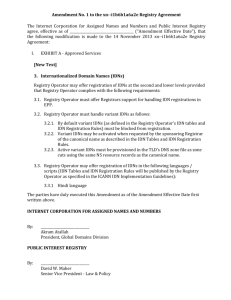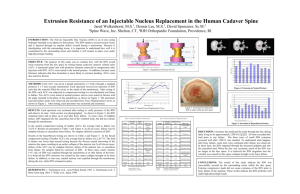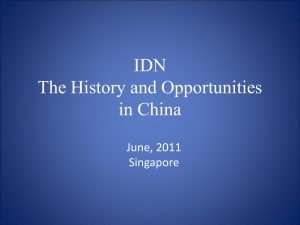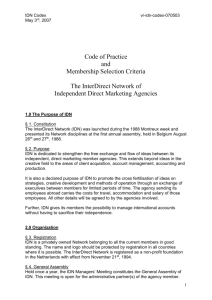Creating a Network Strategy: A Longitudinal Case Study of a
advertisement
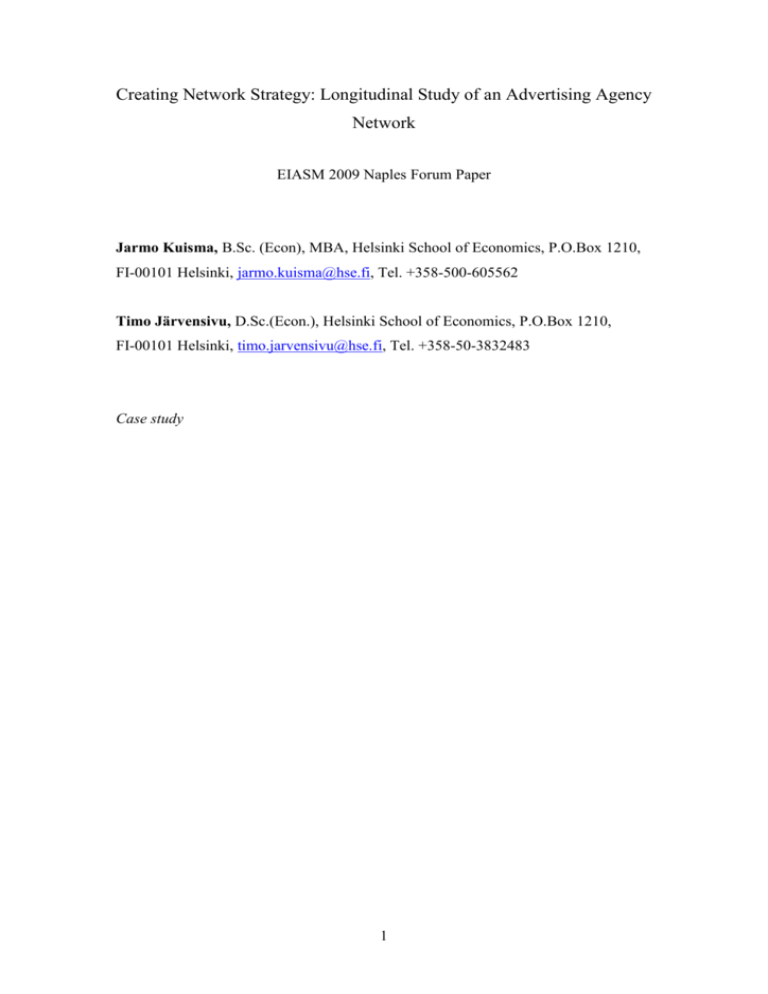
Creating Network Strategy: Longitudinal Study of an Advertising Agency Network EIASM 2009 Naples Forum Paper Jarmo Kuisma, B.Sc. (Econ), MBA, Helsinki School of Economics, P.O.Box 1210, FI-00101 Helsinki, jarmo.kuisma@hse.fi, Tel. +358-500-605562 Timo Järvensivu, D.Sc.(Econ.), Helsinki School of Economics, P.O.Box 1210, FI-00101 Helsinki, timo.jarvensivu@hse.fi, Tel. +358-50-3832483 Case study 1 Purpose To describe and develop a model of network strategy creation in a marketing agency network context. Approach and methodology We explore the strategy development of a global direct marketing agency network from 1988 until 2009. The network has grown from a loose alliance of a few direct marketing agencies into a global network employing 1500 people. We track the formation of the network and examine the evolution of its strategy. The data include key informant interviews, information from a questionnaire and documentation on the history of the network. Findings The resulting description and model incorporates notions of a dynamic process of strategy development that is based on both top-down deliberate design and bottom-up emergence. Implications Network strategizing is a dynamic process of balancing the various goals and needs of network members. The study proposes instruments that would allow managers to take the nature of network strategy into account more effectively. Originality and value This study provides a longitudinal perspective on the dynamics of network strategy creation with an emphasis on balancing its deliberate and emergent aspects. Key words: service network, marketing agencies, network strategy, direct marketing, entrepreneurial networks 2 1 Introduction This paper examines the strategy creation processes of an international network of independent direct marketing service agencies. International business strategies and practices are increasingly based on business networks and the network form of collaboration has become one of the major sources of competitive advantage (Hinterhuber, 2002). Although collaboration, network structures, and management have been studied in various contexts, little research has been carried out in international advertising and strategic contexts. While cooperation such as dyadic partnerships, alliances or coalitions have been studied in marketing and distribution contexts, much of the research has focused on distribution, industrial companies and buyer-supplier chains (Dubois et al., 2003). Although research on entrepreneur networks has looked at cooperation and competition (Tjosvold and Weicker 1993) as well as member involvement and trust (Malewicki, 2005), the empirical studies are often limited to analysis of dyads (O‟Donnell et al. 2001; Grant and McLeod 2007). Longitudinal research on entrepreneurial marketing service business is also scant. This abductive, longitudinal retrospective case study investigates the 20-year strategic development of a network of 30 direct marketing agency entrepreneurs from around the world seeking stronger positions in international markets. Combining the literature of entrepreneurial networks, advertising agency networks, and strategy creation, and results from our case study, we develop a framework for strategy creation by an entrepreneur network. Finally, we provide some managerial implications. 2 Theoretical framework: creating a network strategy in an entrepreneurial advertising agency network 3 2.1 Entrepreneurial networks A number of studies have shown that networks are a key source of competitive advantage to entrepreneurs (Malewicki 2005, Greve and Salaff 2003, O‟Donnell et al. 2001). Entrepreneur network organizations (ENOs) are member-based organizations that sponsor structured activities and seek to support growth by their member firms as well as interaction among the members and with various resource providers such as subcontractors, research organizations, and investors (Malewicki 2005). These networks are formal in the sense that they have a structure to facilitate networking and knowledge exchange. They are also important in spurring informal connections between their members. The importance of trust and commitment, or social capital, to entrepreneurial networks has been shown in a number of studies (Malewicki 2005, Greve and Salaff 2003). Informal connections, built on trust and commitment, are important for network success, since it has been shown that trust and commitment mediate those member behaviors that increase network success: these include level of participation, co-production activities, and retention of network members (Malewicki 2005). Strategies to improve trust and commitment and thus members‟ behavior include enhancement of member interdependence (the ability to build valuable connections between members), recognition of members (e.g. awards presented at ceremonies), recruitment efforts (the ability to recruit diverse and high quality members), and the ENO‟s core service performance (the quality of the key services provided by the ENO to its members). (Malewicki 2005) Commitment as a concept has at least three central components: instrumental, affective, and normative (Malewicki 2005). Instrumental commitment comprises the perceived costs associated with leaving the organization, i.e. there is an economic stake in the relationship based on self-interest. Affective commitment is the emotional attachment defined as favorable attitudes and feelings towards the network. Finally, normative commitment is the perceived moral obligation to stay in the network, e.g. feelings of responsibility toward the organization. Malewicki (2005) shows that 4 though all three kinds of commitment have an impact on ENO outcomes, the normative side seems to be the most powerful connection to the level of member participation or involvement. The most important ways to improve members‟ trust and commitment seemed to be the enhancement of member interdependence and key service performance. However, Malewicki (2005) found an interesting negative relationship between trust and participation. It would seem that over the long term, the level of participation in high trust relationships may decrease because the members learn to know each other well. In addition, brokers, or key actors and persons within the organizations who are well connected and in key positions to facilitate various network initiatives, may perform an essential role in facilitating trust and commitment in a network (Huggins 2000). This may be true especially in the early phases of the network and when new members are recruited. The most effective network brokers were able to support both the “hard” economic and business interests and the “soft,” more social interests of the network members. To sum up, as shown in Figure 1, an ENO may offer several benefits to its members. These outcomes are the result of three main components: member participation, coproduction, and retention of members (Malewicki 2005). The ENO may use at least four major strategies to improve its performance: enhancement of member interdependence, recognition, recruitment efforts, and core service performance. The effect of these strategies on the performance of the network is mediated by trust and commitment among both the network members and between the members and the hub organization. (Malewicki 2005) 5 Entrepreneur network strategies Performance of an entrepreneur network Enhancement of member interdependence Recognition Outcomes for the network members, examples Knowledge transfer Member participation Internationalization Trust and commitment Co-production among members Joint resource usage Recruitment efforts Retention of members Business growth Core service performance Fig 1. Entrepreneur network organization strategies, performance, and outcomes for its members. 2.2 Networks in the advertising industry Networking is a key feature of the business activities of small firms operating in the advertising industry. These firms offer knowledge-intensive professional services whose effective production depends on close, information-rich relationships with clients and partners (Boojihawon 2007). A number of articles have dealt with various types of advertising agency relationships and networks. Most of these have concentrated on the study of agency-client relationships; only a few have dealt with networks among advertising agencies (see, however, Kim 1995, Grant and McLeod 2007, and Boojihawon 2007). In general, the focus of research on relationships among advertising agencies have shifted from exploring dyadic relationships to studying multi-party networks. This has followed a more general shift in relationship research towards network research, and a more specific shift from a market dominated by dyadic agency-client relationships to a market involving networks among multiple, fragmented parties such as advertising and media agencies, research service providers, and others (Grant and McLeod 2007). Internationalization is also one of the drivers of network formation in the industry. Entering into networks enables small advertising agencies to internationalize more rapidly and effectively than they could on their own and also reduces the risks 6 entailed in investment in internationalization. Internationalization may be driven by a client-following strategy, whereby the agency starts its internationalization efforts to respond to its clients‟ needs or by a market-seeking strategy, whereby the agency proactively looks for new international clientele. (Boojihawon 2007) The internationalization strategies of small advertising agencies may range from tightly integrated networks to loose collaboration arrangements. This is true of any types of entrepreneurial network organizations (ENOs). In a more tightly integrated network it is possible to achieve greater internationalization efficiencies compared with loosely integrated networks. However, tightly integrated networks require agencies to trade-off some of their autonomy and control. The network may also be based on a uni-polar strategy (one central coordinating actor and many members) or on a multi-polar strategy (many members, but no central actor). (Boojihavon 2007) Boojihavon (2007) studied the internationalization of small, independent advertising agencies and found that they follow different networking strategies, some of which are tighter and some looser. Some agencies have consolidated and formed large, tightly controlled transnational advertising agencies (Kim 1995). Kim (1995) shows how these transnational agencies dominated the markets for over the thirty year period from 1960 to 1989 with tightly integrated networks and access to the capital and research resources of conglomerates. However, entrepreneurial firms often like to retain their independence and thus are not likely to trade off between autonomy and control. They will go forward with a looser networking structure. The functioning of these looser advertising agency networks requires trust and commitment: closeness of agency purpose and philosophy, personal chemistry, effective power relations, and a high degree of trust (Grant and McLeod, 2007). 2.3 Dynamics of strategy creation Strategy creation in entrepreneurial networks is often pictured as being emergent, or driven by current network structures and social embeddedness, and not as being built 7 through deliberate strategic action (Ozcan and Eisenhardt 2009). However, in their recent study, Ozcan and Eisenhardt (2009) show how this deterministic account of building a network strategy is in many cases flawed, and that entrepreneurs can use various deliberate strategies to their advantage. The debate over deliberate and emergent strategizing is echoed in much of the strategy creation literature. From a more mechanistic perspective, strategy creation is a deliberate process of designing and implementing a top-down strategy. From a more emerging or organic perspective, strategizing is a more complex process of various interactions between strategic events and actions or between the practices, praxis and practitioners of strategy (Farjoun 2002). Strategy research often looks at strategizing through the dichotomy of strategy formulation and strategy implementation. However, both strategy process research (Hutzschenreuter and Kleindienst 2006) and strategy as practice research (Whittington 2006, Whittington 2007, Denis et al. 2007) reject this dichotomy and look at strategizing as a phenomenon involving both deliberate strategy formulation and socially embedded emergence. Farjoun (2002), for instance, offers a model that emphasizes strategizing as a continuous, emerging co-alignment between the intended strategy, firm structure, environment, and the resulting performance. The deliberate creation of strategy faces at least three kinds of challenges: individual actor autonomy leads to collective paralysis as individuals are free to dissociate themselves from centrally established strategy, participative strategizing may produce inflationary consensus at the expense of realism, and the diffuse power and divergent objectives of the actors dilute strategic change initiatives in their implementation phase (Denis et al. 2007). In such settings it is possible that “through the cumulative activities of autonomous professionals, or through spontaneous convergence, a certain consistent orientation became evident that an outside observer would recognize as „strategy‟” (Denis et al. 2007, 181). Some strategy as practice researchers seem to offer the view that strategizing is a phenomenon arising mostly from routines of strategy making, rarely involving deliberate strategic action. For instance, Chia and MacKay (2007, 233) argue that 8 goal-directed, deliberate strategizing “represents an exception to the more mundane everyday practical coping that takes place.” However, we embrace the view that the routines of strategizing as well as managerial cognition are not uncontrollable phenomena and can be purposefully influenced (see also Hutzschenreuter and Kleindienst 2006, and Ozcan and Eisenhardt 2009). This perspective acknowledges that the practices and limitations of managerial cognition may delimit strategizing, but emphasizes that strategizing is also the product of purposeful, deliberate action. Strategizing may also be an iterated process of resources allocation (Noda and Bower 1996). Strategies may gain momentum if they are supported by successful resource allocations, and a negative cycle can take place if sufficient resource allocations are not made or are made but do not lead to success so that the credibility and legitimacy of the chosen strategy is lost. Strategy creation therefore involves not only deliberate planning of strategic intent by the top management team, but is always influenced and bounded by all other actors in an organization as well as resource-dependencies (Lovas and Ghoshal 2000, Regnér 2003, Noda and Bower 1996). The top management team may be the initiator of explicit, deliberate strategy formulation, but also the people in the periphery of the organization influence strategy formulation, or at least its realization (Regnér 2003). The managerial implications of this perspective are that top managers, who are involved in creating and influencing organizational strategies, have to acknowledge the organic, emergent, and bounded nature of strategy processes. Strategic discussions are not restricted to explicit efforts by the top management team but are also conducted implicitly by other members of the organization (Hutzschenreuter and Kleindienst 2006, Sminia 2005, Regnér 2003). The top management team should thus become aware of their cognitive biases, try to transform implicit and emergent strategizing that takes place in the organization more explicitly and transparently, and watch and encourage the initiatives and criticism that are emerging from outside top management. More importantly, the top management team cannot restrict even its own strategy discussion to explicit “strategy meetings.” On the contrary, strategy is present in all their activities, if not in a more explicit form 9 then at least in an implicit, emergent form. The central managerial question therefore is how to generate the most effective realized strategies (Farjoun 2002), by coaligning deliberate and emerging strategic action and processes. The elements from which strategies are created have been defined in a number of ways. Hutzschenreuter and Kleindienst (2006) consider the environment, the strategic context, organizational characteristics, and performance the major elements of a strategy process. These elements can be defined both as the antecedents and the outcomes of a strategy process, implying inherent dynamics and the holistic nature of strategy creation. Lovas and Ghoshal (2000) offer strategic intent, administrative systems, and actors as the main elements in strategy evolution. Farjoun (2002) introduces four such elements: the strategic goals and actions of a firm, the organization (and administrative and social structures, and resources), firm performance, and the environment. 2.4 A dynamic model of entrepreneurial network strategy creation The literature review in sections 2.1, 2.2 and 2.3 describes strategy creation by an entrepreneurial network as a process of both deliberate and emerging strategic action (see Fig 2). A realized strategy is the result of activities by actors operating at both the firm and the network level. Deliberate strategies may be designed by a top management team, but a realized strategy is the result of both deliberate strategy making and strategic activities that emerge from either inside or outside of the top management team. 10 Firm-level strategizing Network-level strategizing Environment Firms' structure and administrative systems Actors Firms' strategic goals and performance Firms' strategic action Deliberate and emerging Interaction among members Trust and commitment as mediating variables Network structure and administrative systems Actors Network-level strategic goals and performance Network-level strategic action Deliberate and emerging Fig 2. General model of strategy creation in an entrepreneurial network At both the firm and network level, strategy creation involves interaction between at least five key elements: the actors, the strategic goals and performance of the firm/network, the structure and administrative systems of the firm/network, deliberate and emergent strategic action, and the environment. Trust and commitment mediate the interaction among the network members as they engage in strategy creation. 3 Methodology This paper is a single, longitudinal retrospective case study of an international network of independent, entrepreneurial direct advertising agencies, Interdirect Network (IDN). We chose the case study method because it is appropriate for both studying networks and developing theory (Halinen and Törnroos 2004; Yin 2003). IDN was established officially in 1988, with preliminary discussions starting in 1986. We tracked the development of the network from these early days until the beginning of 2009. The data include various materials. Throughout the period beginning in 1988, we had full access to the network‟s correspondence, news letters, board meeting minutes, internal reports and intranet, and memos of yearly network meetings. In the beginning of 2009 we also collected new interview and questionnaire data. The interview data consist of key informant interviews with two persons who have been 11 involved in the IDN network and its steering from the beginning. The questionnaire was targeted to all current IDN members (N=30) and consisted of open-ended questions such as why had they joined the network, what they liked and did not like in the network, and what they thought of the IDN‟s past and future strategies. We received 20 replies, resulting in a 66% response rate. The data were analyzed by arranging them into a timeline and findings patterns relating to strategy creation dynamics. The analytical process has been abductive (Dubois and Gadde 2002), so that our empirical analysis and theoretical work have proceeded simultaneously and in constant dialogue. 4 Case study: The Interdirect Network (IDN) Purpose of the network The Interdirect Network (IDN) is a partially integrated network of independent direct marketing entrepreneurs who do not want to trade off their autonomy and control over their own strategies and operations for more efficient internationalization (see also Boojihawon 2007). The main drivers in the foundation of the network in 1988 were the emerging European Single Market and the need to be competitive with large global advertising agency chains that had started to establish separate international direct marketing chains alongside their conventional agency chains. Three entrepreneurs in the direct marketing business decided to establish the network in 1986. Typically, their companies had earlier used their own personal networks to obtain and adopt new ideas from other markets and the company managers met each other irregularly on a casual basis at international conferences and other direct marketing events. The founders felt that their companies needed an international image and a more effective exchange of information to be more competitive in their home markets and also that new global clients and campaigns could be acquired when a global service network was accessible. 12 Getting started, organized and growing (1988-1991) The network grew quickly due to the personal contacts of the entrepreneurs in the DM business, and in 1988 the official founding ceremonies took place in Montreux during the global direct marketing symposium and fair, which was the main podium for global direct marketers at that time. In 1991 the network had 22 members in 19 countries including the USA, Australia and South Africa. This indicated a change from a European emphasis to a global strategy with the more ambitious aim of acquiring new international business. These goals were probably boosted by the DM industry when new potential clients invested increasingly in customer databases and targeted marketing communication. During this period, strategic planning focused on how to organize and structure the network to meet the needs of members, which included information exchange and coordination of cooperation between divergent markets and companies. As early as 1989, the model of “a network of networks” was presented in which supplier networks such as printing and database companies, letter shops, and consultants were depicted as an outer circle of the IDN. Also, the IDN headquarters - the inner circle was carefully organized and structured from the beginning; it was led by a board and chairman and guided by the network‟s code of practice At this point the network had positioned itself to serve clients who were expanding into international markets; it no longer pursued already established global companies. The latter client segment was left to the big global DM agency chains like Ogilvy & Mather, Grey, and McCann. The network members also handled numerous global client accounts, although only a few of them were shared with other member countries. Network promotions were based on brochures, press releases, participation in campaign contests, and trade fairs. Many member agency managers were invited to serve as speakers and board members of the European DM association, Direct Marketing Association (DMA), and other organizations. Toward the end of this period signs of recession were already apparent in the advertising business and members also expected more business and services from the headquarters: “it is a true paradox [that] only after 1 -2 years in cooperation the 13 largest criticism comes from inactive members” (board meeting minutes). The issue of whether to be a casual, social network or a structured competitive network divided members and headquarters was not certain whether the network should emphasize clients or members Shakiness in economy and liveliness in strategic planning (1992 -1994) Recession in 1992 hit the entire advertising industry hard, although entrepreneurial and independent DM agencies seemed to survive more easily. Still, members in some countries left the network and new members were sought to take their place. There were also delays in payment of the annual fee of USD1500 at that time. Although the Montreux Symposium ended and the global platform for international direct marketers ceased to exist, EDMA, DMA and domestic DM events remained. “The network was weak compared with its competitors” comments a board member (board meeting minutes). Competition for new client accounts was tough even in domestic markets but the idea of new global business was not entirely abandoned. This economically difficult period boosted a variety of discussions and proposals for a new IDN structure, strategy and promotion. The network code of practice was revised, including IDN‟s mission, values and the contract with members. A comprehensive study of IDN‟s strategy, environment, competition and members‟ markets was carried out, including a one-day workshop with board members to discuss the network‟s mission, do a SWOT analysis, and evaluate competitiveness. Seven alternative strategies ranging from a loose independent network to a fully integrated IDN company owned by the members were presented. Competitors‟ structures and actions were followed up and finally an evolutionary model of the network was introduced to 20 managers at the members‟ meeting. In phase one of the evolution process, the network was seen as a social club of independent company members concentrating on information exchange. In phase two the network would be more structured and hire a central international coordinator for new business. In phase three IDN would be a separate company owned by members and members would add IDN name into their company names. Finally, in phase four all members would be one company under IDN name only. Managers voted for future 14 development but final legitimization from members was not achieved because of the investments involved. To solve the problem, eight versions of the joint venture model were developed. These proposed that suppliers and other actors in the industry would be able to buy IDN shares. The agenda included a European chapter concept with an IDN owned by the stronger European members and with a lower fee for affiliate members. The distance of peripheral members was considered an obstacle to participation in regular annual network meetings so a regional chapter structure was suggested. The polarity between member agencies became more apparent; the stronger members were willing to take risks and invest more while the others argued that “we need a solution, not an institution” (board meeting minutes). This remark obviously reflected the desire of members to keep their independence and remain their own bosses. In spite of the recession, the network and members continue promotions creating test campaigns to attract the attention of international clients and attending conferences and exhibiting in trade fairs. The popularity of internal meetings such as the IDN Creative Forum grew among the members as big international DM venues disappeared or turned into less significant domestic events. The IDN newsletter was published to improve communication between headquarters and members; the Internet and email had not yet emerged. Although the issue of member quality was discussed, there seemed to be an underlying assumption that all agencies were members for the same reasons, although their resources, capabilities and markets varied considerably. Ahead 2000 cut back (1995 -2001) The network headquarters moved from London to Amsterdam and a secretary was hired to help member correspondence. The 22 member agencies seemed to be satisfied with exchanging information at internal meetings. Discussions on long- and short-term IDN plans continued but were not put into effect: “a short- and long-term plan for IDN, mutual business - forget it” (board meeting minutes). However, new structural and strategic ideas popped up, an exchange of staff was encouraged, information was acquired from networks in other industries, and board‟s governance practice was changed by rotating the chairmanship of the IDN board in order to 15 encourage the involvement of members and gain their trust. The headquarters, which was now renamed the secretariat and/or the IDN central, was restructured, the mission was revised, client list was updated, press releases were submitted but acquisition of new clients was not flourishing. Again, new vistas and versions of centralized strategy and structure appeared on the agenda. In 1997 the Expert Circle model was proposed to members. The aim of the model was based on the lead agency‟s role in making use of the entire network‟s special skills and capabilities for clients. With respect to the knowledge of the entire network about a variety of industries, the strategies of clients and creative design and production, IDN had the capacity to build capable teams to meet the needs of almost any international client by joining forces and making the tacit knowledge of the network. However, nothing happened. The IDN website was not at a satisfactory level in 2000 (some members had their websites ready in 1995) and during the IT bubble the number of paying members dropped to ten. The network did not react early enough to environmental changes such as the growing importance of the Internet. New actors had appeared in the market, the media became more fragmented and campaigns and client needs less integrated. The debate on strategy goes on (2002 – 2008) The network grew further and had members in 33 countries. However, because of the distances involved and differences in the culture and infrastructures of undeveloped markets, many members played a passive role in network development and were difficult to integrate with the network. The IDN website and Google search engine campaign were on the agenda. Internal member meetings and socializing were well received by members. One of the founder members started to act as an advisory chairman concentrating totally on developing the network and handling contacts with members. His work and ideas significantly influenced strategic discussions throughout the history of IDN and his character has been the “social glue” that has helped the network to survive from 16 establishment. The board keeps on discussing the future IDN structure, new business, and promotion, but no action took place. Current Situation 2009 To update the situation, we presented members with a questionnaire including questions such as why they joined the network, what they like in the network, and what kind of strategic decisions should be made at the moment. 20 members out of 30 replied. Half of the replies came from members in Central Europe and the rest from new members in Eastern Europe as well as more established members in the Nordic countries and other continents. The results show that members are looking primarily for opportunities to meet their professional colleagues and exchange information. Acquiring new global business comes second. Only one member has joined the network because of its clients‟ needs and many members consider that network membership is a value as such, since it supports domestic business. Members especially like information exchange including the IDN intra and the meetings of members but miss new business opportunities. Quite a few members have actually had joint client projects and gained some new business, but mainly through dyadic exchange. Five members out of twenty stated that IDN has helped them to grow their own business, while most members replied that the network had no impact on their business development. Finally, we asked what strategic decisions the network should make in the present situation. The members highlight both the quality of the member agencies and the IDN service and the search for global position, branding for the network, new business and the hope that the IDN central would provides a stronger platform for international promotion and campaigns. On the other hand, a couple of members gave the following response: “do nothing, it is only a waste of time and money” or that “the network is fine like this.” At the same time the majority of network members were prepared to cut costs and personnel because of the global recession. 17 5 Conclusion and discussion The key empirical findings of the case study revolve around the dynamics of a few strategic elements: the firm and network level goals and performance, strategic actions, and network structure and administrative systems. The study on the dynamics of these elements has led to the following insights. The network was established quickly and basic structures and even future visions were already predetermined in 1989, less than one year after the official founding. The network went through several shakeouts: during the 1992 recession, the 2000 IT bubble and a downturn in 2008-2009. During these critical times the network typically undertook to elaborate its mission, strategy, and structures. Dozens of different strategies and models have been proposed to network members but no action has been taken because some of the members have been unwilling to invest time and money in the network development. A polarization of members‟ strategies emerged quite early. More established and wealthier member companies were willing to invest more in IDN for new business while other members were happy with an exchange of information and meetings in return for a minor membership fee. This led to the mismatch of strategic goals and network structure depicted in figure 4. 18 No-one is here?? Is this feasible?? • Loose network structure • Entrepreneur network • Independent members • Informal trust-based networking IDN's current, emergent strategy is here Fit between firms' strategic goals and network structure Fit between firms' strategic goals and network structure Strategic goal set 1: • Growth from new international clients • Serving and growth from existing clients • New professional knowledge Firms' strategic goals Non-fit between firms' strategic goals and network structure International integrated agency networks are here • Tight network structure • Professionally managed • Non-independent members • Formal contract-based control Network structure and administrative systems Strategic goal set 2: • Entrepreneurship & independence • Social benefits & personal relationships • Serving and growth from existing clients • New professional knowledge IDN's deliberate strategizing is here?? Is this feasible?? Non-fit between firms' strategic goals and network structure Figure 4. Match and mismatch of agency network strategies Throughout its history, IDN has been balancing two strategic and perhaps competitive goal sets. Gaining new global accounts requires clients‟ trust and sometimes even guarantees to provide the services required. A loose network structure, or a “social club” of members, may not be enough to convince such international clients when competitors offer professionally and centrally managed DM agency chains, clear contracts and guarantees, and more extensive assortment of services. Conversely, IDN is clearly a loose entrepreneur network organization (see Malewicki 2005); its values are independence, autonomy, and preservation of agency freedom instead of tighter network structures with deliberate network strategies and control. During its history, both the board of the network and individual members have suggested a number of deliberate competitive strategies, often based on a tight, professionally managed network structure, to attract more business from international clients. These suggestions, however, were rejected on a regular basis by members. The members have been unwilling to lose their autonomy and to invest in the network to the extent required to make the central organization stronger. 19 Obviously the strategy to stay independent and keep the network flexible has finally proved successful in the sense that the network has survived several crises. For instance, in 2001 the network had shrunk to only ten members and a heavy organizational structure with high fixed costs might have caused the IDN central organization serious financial problems, perhaps even bankruptcy. However, demands for new business and better global branding and market positions for the IDN are still alive among several IDN managers. The network has probably only two options: to make no changes or to find a way to get new business without sacrificing independence, money, and flexibility. The 2009 survey revealed that some members actively seek opportunities with other members to gain new business and many projects and campaigns have been completed in several countries in chorus with other network members. The approach to cooperation has somewhat resembled the expert circle model already discussed by the board in 1997. The model is depicted in figure 5. Figure 5. The Expert Circle Model 20 The model is based on the lead agency philosophy in which a lead agency coordinates the entire campaign and gathers the expertise, tacit knowledge, and specified services from those members who have the best capabilities and techniques in the area of business. Our questionnaire shows that the members‟ skills cover virtually every area of knowledge of DM, which makes this strategy quite plausible. The network could build international expert teams for their clients and projects without increasing the costs or bureaucracy. The model also offers the option of internal learning to network members. The staffs of those members who want to learn about new industries or techniques can participate in projects as illustrated in Figure 5. Perhaps in the longterm, members from some countries could concentrate on project coordination and client relations only and buy creative and other solutions from other network members. Companies that use freelancer networks for all other services already exist in the DM service industry. The model would benefit clients by providing them with the best expertise of the network and increasing the motivation of members. The Expert Circle Model is a rather loose network structure, but it is more attractive to international clients than a mere “social club” of entrepreneurs. An Expert Circle strategy might therefore function as a middle ground strategy (see Figure 6) that would at least partially solve the “fit” challenge between IDN‟s different strategic goal sets and the network structure and administration 21 No-one is here?? Is this feasible?? • Loose network structure • Entrepreneur network • Independent members • Informal trust-based networking IDN's current, emergent strategy is here Fit between firms' strategic goals and network structure Fit between firms' strategic goals and network structure Strategic goal set 1: • Growth from new international clients • Serving and growth from existing clients • New professional knowledge Firms' strategic goals Non-fit between firms' strategic goals and network structure International integrated agency networks are here • Tight network structure • Professionally managed • Non-independent members • Formal contract-based control Network structure and administrative systems Strategic goal set 2: • Entrepreneurship & independence • Social benefits & personal relationships • Serving and growth from existing clients • New professional knowledge IDN's deliberate strategizing is here?? Is this feasible?? Non-fit between firms' strategic goals and network structure Figure 6. An Expert Circle strategy as a middle ground approach between IDN goals and the network structure Finally, the modest amount of international business for IDN during the 20 years raises a question. Has there ever been a market for global DM services and is there one now? In a way, this question was already tackled in 1992 in one of the strategic reports as follows: “none of the founders or new members ever asked themselves whether that kind of service was needed or not”. The global business of big international DM chains was obviously client-driven whereas IDN was memberdriven without existing global clientele. That is why bottom-up emergent strategies rather than top-down deliberate strategies have kept IDN alive all these years. Overall, if we look at the dynamics of the strategic elements in the IDN evolution, we see how IDN‟s strategy has evolved through the interplay of environmental changes and demands as well as strategic actions, goals and performance, and structures and administrative systems at both the firm and the network level (see Figure 7). 22 Environment - International competition - New technologies - Fragmentation of advertising industry Network-level strategizing: deliberate and emerging Member-level strategizing: deliberate and emerging Firms' strategic actions toward the network Firms' strategic goals and performance Participation Entrepreneurship and independence Co-production Growth from current clients (client-following) Stay as member or exit Growth from new clients (market-seeking) Pay standard fee or increase investment New professional knowledge Investments in internationalization Network's strategic actions toward members Enhancement of member interdependence Member participation Recognition Level of trust and commitment varies among members Co-production among members Recruitment efforts Retention of members Core service performance Social benefits & personal relationships Network structure and administrative systems Firms' structure and administrative systems ? Network's strategic goals and performance ? Code of practice (formal and informal) Meetings and forums Membership fee (level and structure) Network structure (tight or loose) Fig. 7. Strategy dynamics in IDN. The tension or non-fit between certain firm-level strategic goals (independence and independence vs. growth from new international clients) and network-level structures (tight vs. loose structure, respectively) has been obvious throughout IDN history. The members have engaged in various strategic actions toward the network, choosing for example whether to participate, to co-produce with other members, or to remain members. The IDN secretariat has also engaged in strategic action to enhance members‟ interdependence, give recognition to them, recruit new members, and offer high quality core services (such as organizing meetings and forums) to improve member participation, co-production, and retention. These strategic activities and the tension between the strategic goals and network structure have driven the evolution of IDN‟s strategy. Despite attempts at changing it, the strategy has remained virtually the same throughout the IDN‟s history. The strategy is based on a fairly loose network with an emphasis on independence and 23 entrepreneurship, gaining knowledge and enjoying social benefits. Top IDN managers have time and again offered the vision of a tighter structure to attract international clients, but have had no success in implementing this strategy. The top-down attempts to create a deliberate strategy with a tight structure have been overcome by the bottom-up emergence of strategy with a loose structure. A middle ground strategy, namely the Expert Circles, deliberately conceived as an alternative strategy by the top management, may offer a way to attract international clients. However, adoption of this strategy, too, will depend on the will and action of the IDN members. IDN‟s strategy evolution and dynamics point to the importance of the emergent nature of strategy creation (Whittington 2006, Whittington 2007, Denis et al. 2007; Farjoun 2002). There have been many deliberate attempts by the IDN top managers to change the strategy of the network, but in line with the results of other studies, our study also shows how deliberate top-down strategizing is conditioned by factors that make the strategy emergent or bottom-up (Lovas and Ghoshal 2000, Regnér 2003, Noda and Bower 1996). We highlight the fact that the network has been tackling the same strategic challenge throughout its history, namely to resolve the fit between certain firm-level strategic goals and the optimal network structure needed to reach these goals. The social aspects of the network, a culture based on trust and commitment, seems to be very important for the members – the IDN entrepreneurs do not want to replace it with more rigid, contract-based control of a tighter network structure. This is in line with other studies that highlight the role of social capital or trust and commitment as key governance mechanisms of entrepreneur networks (Malewicki 2005, Greve and Salaff 2003). A key insight from this long history of strategy development in IDN – the strategy has remained virtually the same from the beginning despite deliberate attempts to change it – is that even a long history of attempts at deliberate strategy making may not change the realized strategy. The member firms in IDN are independent entrepreneurs and want to stay independent – this limits the scope for choosing a network level strategy that would rest on a structure that limits the members‟ independence. This implies that the top management cannot force change on a network strategy if the 24 fundamental conditions do not allow such change. They must acknowledge these limitations and seek strategies that go around the limitations. For instance, in the IDN case there is the possibility that a middle ground strategy based on a semi-formal project structure might satisfy both the need to attract new business and to stay independent. This is in line with the idea that top managers have to acknowledge the emergent and bounded nature of the strategy process so that they can adapt their deliberate strategizing to accommodate the limitations (Hutzschenreuter and Kleindienst 2006, Sminia 2005, Regnér 2003). 6 References Boojihawon, D. K. (2007). Network Dynamics and the Internationalisation Process of Small Advertising Agencies. The Service Industries Journal, 27(6), 809-829. Chia, R. and MacKay, B. (2007). Post-processual challenges for the emerging strategy-as-practice perspective: Discovering strategy in the logic of practice. Human Relations, 60(1), 217-242. Denis, J.-L., Langley, A., and Rouleau, L. (2007). Strategizing in pluralistic contexts: Rethinking theoretical frames. Human Relations, 60(1), 179-215. Dubois, A., and Gadde, L.-E. (2002). Systematic Combining: An Abductive Approach to Case Research. Journal of Business Research, 55(7), 553-560. Dubois, A., and Gadde, L.-E., Mattsson, L – G. (2003). Change and Continuity in the Supplier Base: A case Study of a manufacturing Firm 1964-2002. Journal of Customer Behaviour, (2). Farjoun, M. (2002). Towards an organic perspective on strategy. Strategic Management Journal, 23, 561-594. Grant, I. and McLeod, C. (2007). Advertising agency planning – conceptualising network relationships. Journal of Marketing Management, 23(5-6), 425-442. Greve, A. and Salaff, J. W. (2003). Social Networks and Entrepreneurship. Entrepreneurship Theory and Practice, Fall, 1-22. Halinen, A., and Törnroos, J.-Å. (2004). Using Case Methods in the Study of Contemporary Business Networks. Journal of Business Research, 58(9), 12851297. 25 Hinterhuber, A. (2002), “Value Chain Orchestration in Action and the Case of the Global Agrochemical Industry. Long Range Planning, 35 (6), 615-635. Huggins, R. (2000), The success and failure of policy-implanted inter-firm network initiatives: motivations, processes and structure. Entrepreneurship & Regional Development, 12, 111-135. Hutzschenreuter, T. and Kleindienst, I. (2006). Strategy-Process Research: What Have We Learned and What Is Still to Be Explored. Journal of Management, 32(5), 673-720. Kim, K. K. (1995). Spreading the Net: The Consolidation Process of Large Transnational Advertising Agencies in the 1980s and early 1990s. International Journal of Advertising. 14(3), 195-217. Lovas, B. and Ghoshal, S. (2000). Strategy as guided evolution. Strategic Management Journal, 21, 875-896. Malewicki, D. S. (2005). Member involvement in entrepreneur network organizations: the role of commitment and trust. Journal of Developmental Entrepreneurship, 10(2), 141-166. Noda, T. and Bower, J. L. (1996). Strategy making as iterated processes of resources allocation. Strategic Management Journal, 17, 159-192. O‟Donnell, A., Gilmore, A., Cummins, D. and Carson, D. (2001). The network construct in entrepreneurship research: a review and critique. Management Decision. 39(9), 749-760. Ozcan, P. and Eisenhardt, K. M. (2009). Origin of alliance portfolios: entrepreneurs, network strategies, and firm performance. Academy of Management Journal, 52(2), 246-279. Regnér, P. (2003). Strategy Creation in the Periphery: Inductive Versus Deductive Strategy Making. Journal of Management Studies, 40(1), 57-82. Sminia, H. (2005). Strategy formation as layered discussion. Scandinavian Journal of Management, 21, 267-291. Tjosvold, D., and Weicker, D. (1993). Cooperative and Competitive Networking by Entrepreneurs: A Critical Incident Study. Journal of Small Business Management, January, 11-20. Whittington, R. (2006). Completing the Practice Turn in Strategy Research. Organization Studies, 27(5), 613-634. 26 Whittington, R. (2007). Strategy Practice and Strategy Process: Family Differences and the Sociological Eye. Organization Studies, 28(10), 1575-1586. Yin, R. K. (2003). Case Study Research: Design and Methods, Sage Publications, London. 27

